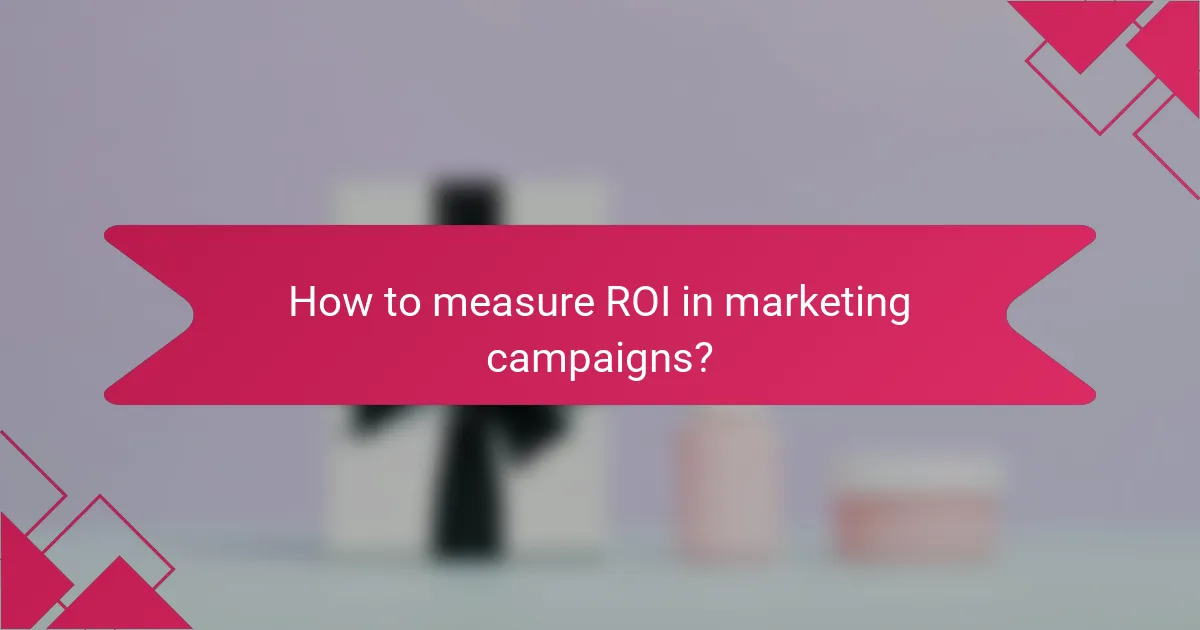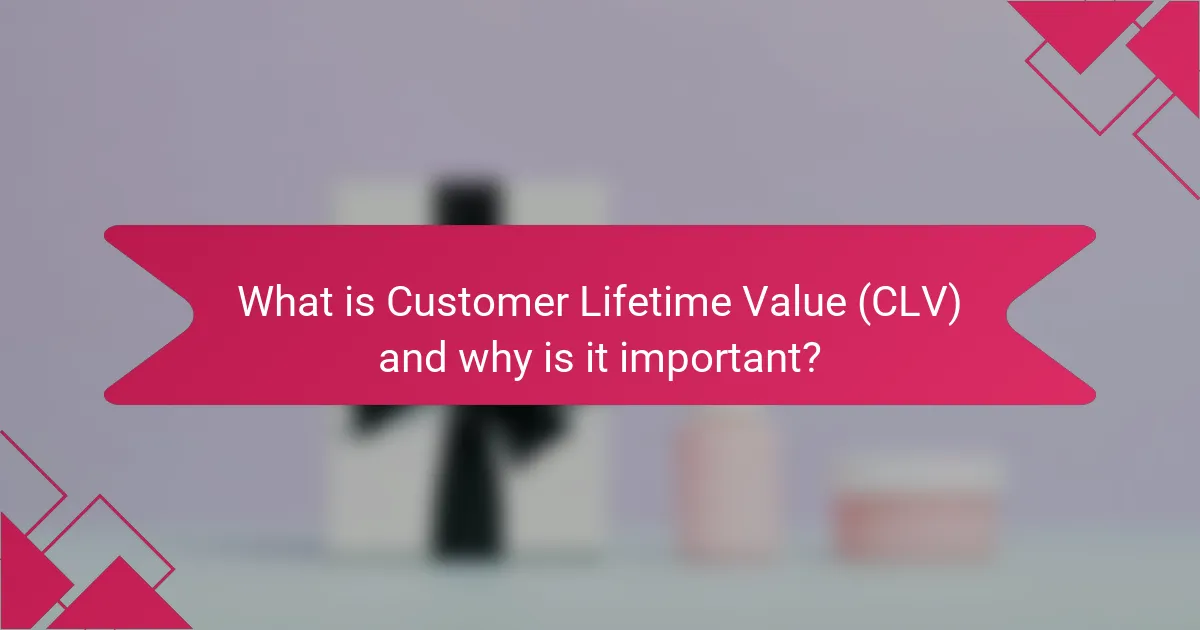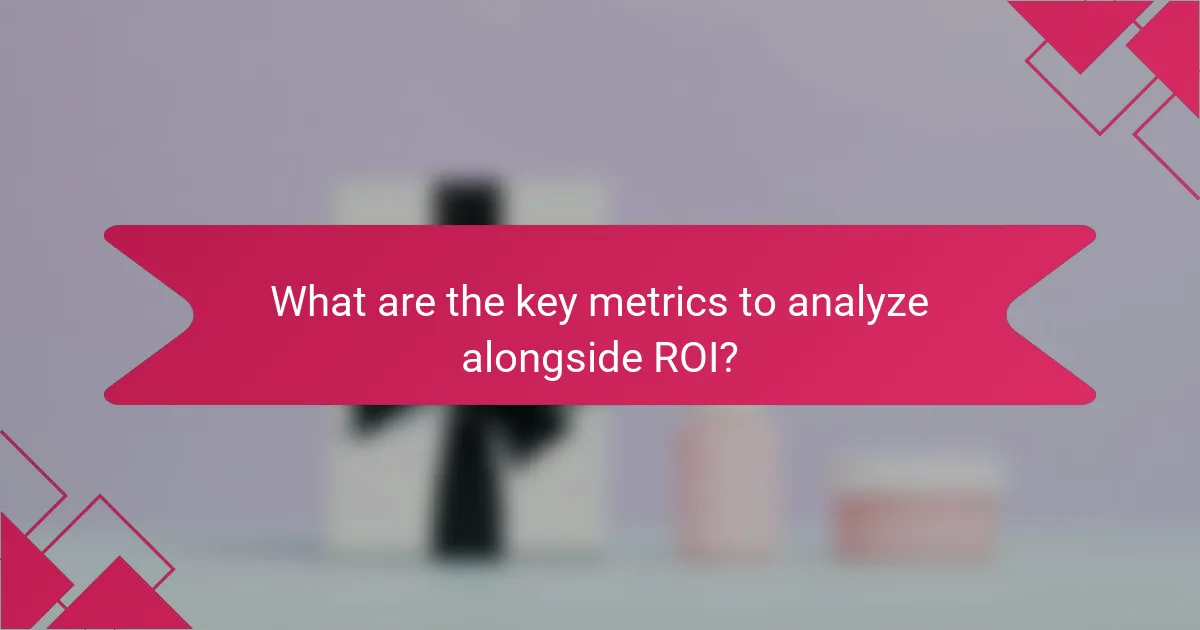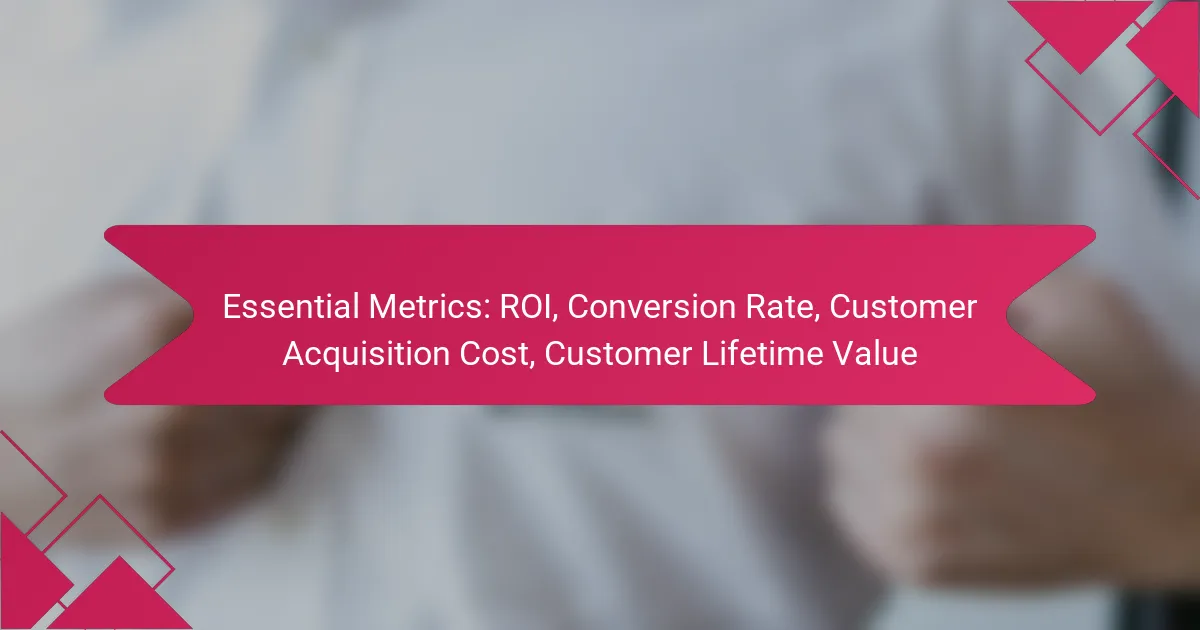Understanding essential metrics such as ROI, conversion rate, customer acquisition cost, and customer lifetime value is crucial for businesses aiming to optimize their marketing strategies. These metrics provide valuable insights into the effectiveness of marketing efforts, the efficiency of customer acquisition, and the overall profitability of customer relationships. By analyzing these figures, companies can make informed decisions to enhance their performance and drive growth.

How to measure ROI in marketing campaigns?
Measuring ROI in marketing campaigns involves calculating the return on investment to determine the effectiveness of marketing efforts. This metric helps businesses understand how much profit they generate relative to their marketing costs.
ROI formula: (Net Profit / Cost of Investment) x 100
The ROI formula is straightforward: divide the net profit from the campaign by the total cost of the investment and multiply by 100 to get a percentage. For example, if a campaign generates a net profit of $5,000 and costs $1,000, the ROI would be (5000 / 1000) x 100, resulting in a 500% return.
When calculating ROI, consider both direct costs, such as advertising spend, and indirect costs, like staff time. This comprehensive approach ensures a more accurate measurement of your marketing effectiveness.
Tools for calculating ROI: Google Analytics, HubSpot
Google Analytics is a powerful tool that helps track website traffic and conversions, allowing you to assess the ROI of digital marketing campaigns effectively. By setting up goals and tracking conversions, you can see how much revenue is generated from specific marketing efforts.
HubSpot offers integrated marketing solutions that include ROI tracking features. It allows you to analyze the performance of your campaigns across various channels, providing insights into customer acquisition costs and overall profitability.

What is the ideal conversion rate for businesses in Canada?
The ideal conversion rate for businesses in Canada typically falls between 2% and 5%. This range can vary based on the industry, target audience, and specific business model.
Average conversion rate: 2-5% for e-commerce
For e-commerce businesses in Canada, an average conversion rate of 2% to 5% is considered standard. This means that for every 100 visitors to an online store, 2 to 5 are likely to make a purchase. Achieving rates above this range often indicates effective marketing strategies and a strong product-market fit.
Businesses should regularly monitor their conversion rates to identify trends and areas for improvement. A conversion rate significantly below 2% may signal issues with the website or marketing efforts.
Factors affecting conversion rates: website design, user experience
Website design plays a crucial role in influencing conversion rates. A clean, visually appealing layout that guides users seamlessly through the purchasing process can enhance user engagement and increase conversions. Key elements include intuitive navigation, clear calls to action, and mobile responsiveness.
User experience (UX) is another critical factor. Fast-loading pages, easy checkout processes, and accessible customer support can significantly impact a visitor’s decision to convert. Regularly testing and optimizing these elements can lead to better performance and higher conversion rates.

How to calculate Customer Acquisition Cost (CAC)?
Customer Acquisition Cost (CAC) is calculated by dividing the total sales and marketing expenses by the number of new customers acquired in a specific period. This metric helps businesses understand how much they are spending to gain each new customer, which is crucial for evaluating the effectiveness of marketing strategies.
CAC formula: Total Sales and Marketing Expenses / Number of New Customers
The CAC formula is straightforward: take your total sales and marketing expenses for a given period and divide that by the number of new customers gained during the same timeframe. For example, if you spent $10,000 on marketing and acquired 100 new customers, your CAC would be $100.
It’s essential to include all relevant costs in your calculations, such as salaries, advertising costs, and any tools or software used for marketing. This comprehensive approach ensures that your CAC reflects the true cost of acquiring customers.
Importance of CAC in budgeting
CAC plays a vital role in budgeting as it helps businesses allocate resources effectively. By understanding CAC, companies can determine how much they can afford to spend on acquiring new customers while still maintaining profitability.
Monitoring CAC over time allows businesses to identify trends and make informed decisions about scaling marketing efforts. A rising CAC may indicate inefficiencies in marketing strategies, prompting a reevaluation of tactics to improve customer acquisition.

What is Customer Lifetime Value (CLV) and why is it important?
Customer Lifetime Value (CLV) is a metric that estimates the total revenue a business can expect from a single customer throughout their relationship. Understanding CLV is crucial as it helps businesses make informed decisions about marketing strategies, customer retention efforts, and overall profitability.
CLV formula: Average Purchase Value x Purchase Frequency x Customer Lifespan
The formula for calculating CLV is straightforward: multiply the average purchase value by the purchase frequency and then by the customer lifespan. For instance, if a customer spends $50 on average per purchase, makes purchases four times a year, and remains a customer for five years, the CLV would be $1,000.
To break it down further, the average purchase value represents the typical amount spent per transaction, while purchase frequency indicates how often a customer buys within a specific timeframe. Customer lifespan refers to the duration a customer continues to make purchases, which can vary widely across industries.
CLV helps in understanding customer profitability
CLV is essential for assessing customer profitability, as it provides insights into how much revenue each customer generates over time. By analyzing CLV, businesses can identify their most valuable customers and tailor marketing efforts to retain them, ultimately boosting overall profitability.
Additionally, understanding CLV can guide budget allocation for customer acquisition. If the cost to acquire a customer is significantly lower than their CLV, it indicates a healthy business model. Conversely, if acquisition costs approach or exceed CLV, it may signal the need for strategic adjustments.

What are the key metrics to analyze alongside ROI?
Key metrics to analyze alongside ROI include customer retention rate, average order value, conversion rate, customer acquisition cost, and customer lifetime value. These metrics provide a comprehensive view of business performance and help in making informed decisions to optimize profitability.
Metrics: Customer Retention Rate, Average Order Value
Customer retention rate measures the percentage of customers who continue to engage with a business over a specific period. A high retention rate indicates customer satisfaction and loyalty, which can significantly impact overall profitability.
Average order value (AOV) calculates the average amount spent each time a customer places an order. Increasing AOV can enhance revenue without the need to acquire new customers, making it a crucial metric for evaluating sales performance.
Importance of tracking multiple metrics for comprehensive analysis
Tracking multiple metrics is vital for a holistic understanding of business health. Relying solely on ROI can obscure underlying issues, such as high customer acquisition costs or low retention rates, that may affect long-term profitability.
By analyzing various metrics together, businesses can identify trends, make data-driven decisions, and implement strategies that enhance customer experience and drive growth. For instance, if the customer acquisition cost is high but the retention rate is low, it may signal a need to improve customer service or product quality.

How do ROI and CAC influence marketing strategies?
ROI (Return on Investment) and CAC (Customer Acquisition Cost) are critical metrics that shape effective marketing strategies. Understanding these metrics allows businesses to allocate resources efficiently and maximize profitability by ensuring that the cost of acquiring customers aligns with the revenue generated from them.
Adjusting marketing spend based on CAC
To optimize marketing budgets, businesses must regularly analyze their CAC. If CAC is high compared to the revenue generated, it may indicate the need to reassess marketing channels or strategies. For instance, if a company spends $200 to acquire a customer who only brings in $150, it may need to reduce spending or improve targeting.
Consider testing different marketing channels to find the most cost-effective options. For example, shifting from paid ads to organic social media strategies might lower CAC significantly. Regularly monitoring CAC can help identify trends and inform budget adjustments.
Using ROI to optimize campaign performance
ROI is essential for evaluating the effectiveness of marketing campaigns. A positive ROI indicates that a campaign is generating more revenue than it costs, while a negative ROI suggests a need for reevaluation. Businesses should aim for an ROI that is at least three times the investment for a healthy margin.
To enhance campaign performance, conduct A/B testing to compare different strategies and identify which yields the best ROI. Additionally, track metrics such as conversion rates and customer feedback to refine campaigns continuously. Regularly reviewing ROI allows marketers to pivot strategies quickly and allocate resources to the most successful initiatives.

What are emerging trends in measuring marketing effectiveness?
Emerging trends in measuring marketing effectiveness emphasize the importance of data-driven strategies and advanced analytics. Companies are increasingly leveraging technology to track key performance metrics, enabling them to make informed decisions that enhance marketing ROI and overall effectiveness.
Increased focus on data-driven decision making
Data-driven decision making has become essential for marketers aiming to optimize their strategies. By utilizing analytics tools, businesses can gather insights from customer behavior, campaign performance, and market trends. This approach allows for more precise targeting and improved allocation of marketing budgets.
For instance, companies can analyze conversion rates and customer acquisition costs to identify which channels yield the best returns. This enables them to shift resources toward high-performing tactics, ultimately increasing overall marketing effectiveness.
To successfully implement data-driven decision making, organizations should invest in robust analytics platforms and ensure their teams are trained to interpret data effectively. Regularly reviewing metrics such as ROI and customer lifetime value can help maintain focus on performance and guide strategic adjustments.









